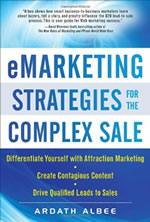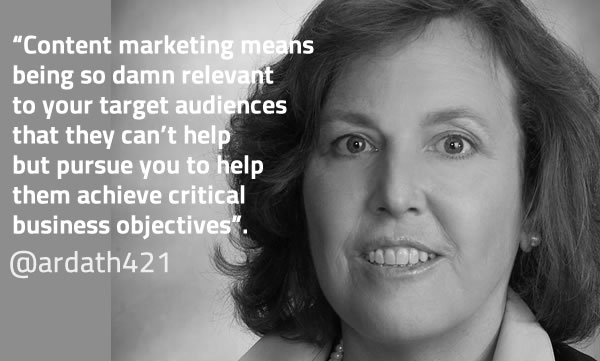
Ardath Albee is one of the smartest B2B marketing and content marketing experts. I’ve been following her since quite some time and, even if we never met, I guarantee you that with Ardath you just know she’ll bring value to the table, based on experience.
On top of being a B2B Marketing Strategist, Ardath Albee is also author of eMarketing Strategies for the Complex Sale. Ardath worked for companies such as Cisco, Adobe and Teradata.
Regarding content marketing, Ardath has an absolute buyer-centric approach. She’s also a buyer persona expert and has launched Up Close & Persona, a tool developed to help B2B marketers develop target personas to assist them with content development and strategy. The nice thing about you: it’s to the point, provides you with handy tips when “building” your personas and it steers away from the non-essential in a B2B context.
Quite an introduction. Time for those questions. It’s a long read but every insight shared is a nugget of gold!
Ardath, let me start with a buyer-centric approach to content marketing. How does one start and what are the essential things to take into consideration?

Ardath Albee: The foundation for any marketing – content or otherwise – is your target audiences, buyer personas, customer profiles, industry segments – whatever you want to call this directed and in-depth research and depiction of who buys what from you and why.
Unless you know very intimately who gains value from your products, why they think so and how they do so, how the heck do you know what to say to them. Think about the anxiety you experience when going to a party where you don’t know anyone. You wonder what to say, whether or not they’ll care and if you’ll look good (smart, likeable, impressive, etc.). Why don’t we care as much about what our buyers and customers think of their experiences with our company and our brand?
The process of building relationships is long and requires commitment. I’m just unclear how you can produce, publish and distribute content that attracts and keeps attention if you have no freaking idea what your buyers and customers think and care about. More misleading is thinking that our assumptions are correct without any validation, nor constant refinement given the rapid rate of change.
Buyer personas and archetypes: defining who to impact in B2B and B2C
What should people really know about how to develop buyer personas?
Ardath Albee: What you need to know about personas is a few things. The most important is that personas are composite sketches of target audiences/segments. They are not real people. One of the hardest things is to resist the urge to modify them if the research and interviews are painting a different picture than you’d expected or believed to be true. Don’t invalidate the research based on your beliefs or even a conversation you’ve had with one customer that turned out differently. There will always be differences. What you base personas on is the commonalities that can be identified.
Personas must be active tools that contributes to digital strategy and execution plans. This means they should include:
- First person scenarios – the persona speaking directly to you about a day in their lives – including their views about priorities, challenges and their interactions with the other personas that must reach consensus to make a buying decision.
- In depth objectives. For example, “grow revenues” is not helpful. What does this mean to this specific persona? How does their responsibility for that priority play out given their job role? Get down in the weeds on these. For example, perhaps a team lead for a contact center must help her agents improve empathy and the way they show customers they’re “owning” getting the issue resolved in order to earn the right to make more successful cross and up sell offers.
- Problems – these are the flip side of objectives. What’s getting in the way of your persona’s objectives? How does this manifest? Is it caused by something outside of their control?
- Buyer questions – what are all the questions the persona will need to have answered to build the confidence to make a buying decision? How do they fall into the stages of the buyers’ experience? Can you see the informational flow develop?
- Channels in use and levels of participation. We need to know where our buyers are sourcing information and where we need to go to get their attention. Instead of chasing every new channel that comes out, we need to first make sure those we need to reach are using them.
- Engagement scenarios should be part of every persona. This means taking the time to walk through how you’ll engage them. There’s a big difference between emailing a contact in your database and generating a net new lead. And, once you’ve engaged them, then what? How do you get them to take next steps. What will it take to get them to engage enough to agree to have a conversation with a salesperson? What combination of channels might end up in play? How will other personas become part of this persona’s buying process?
As for developing them, you need to talk to people representative of each persona. Don’t just interview the executive overseeing the project, speak with those who played parts in the decision process. Speak to the people you need to engage. If you can, speak to people involved in “lost” deals as well as new and existing customers.
When interviewing – don’t lead the witness. Ask guiding questions and sit back and let them say what they want to say. If you plant seeds, they’ll say what they think you want them to say and then you don’t have the truth. Therefore, your personas won’t be effective foundations for marketing programs.

Research – don’t stop at interviews. Get over to LinkedIn and search for people who could be your personas. Read a bunch of their profiles and you’ll start getting a feel for patterns of commonalities. Where else can you go and actually see what people like your personas are doing and look like? Look at job listings, analyst reports, and industry publications. Get familiar with the hot topics and what’s attracting the attention of the personas you need to attract. Attend a few webinars that they’d attend and wait to the end to see what questions they ask the speaker.
All of this will feed your thinking and the development of personas.
Are there differences in the ways we used to look at buyer personas before content marketing became more important and today where some people also talk about content marketing personas?
Ardath Albee: You bet. Before, we were looking for ways to pitch them. Now (hopefully) we’re looking for ways to engage them, be more relevant and add value.
If you look at content marketing in a more B2C branding and social context, some people advice not to work with buyer personas but with audiences, sometimes even archetypes? What are your thoughts on that?
Ardath Albee: B2C is a different animal. I know some people will argue with this, but (depending on what you’re selling) demographics data can be infinitely more helpful in being relevant to B2C than B2B. For example, if you know your consumer has two kids, lives in an upscale zip code in the suburbs, and drives a Porsche Cayenne, you would tell a different story than you would to a young couple in a studio apartment in the city who don’t own a car. This type of information can be easily gathered for B2C segments. However, it means nothing in a B2B setting.
In B2C, archetypes like the “over achiever” or “the environmentalist” make sense because you can back them up with population or census or household data which allows you to segment in that way. Tell me how you’d segment for an “over achiever” in a B2B setting.
Then again, we also get caught up in the labels more than we do what they mean. I don’t really care what you call them as long as you do the work to learn what you need to know and choose segments that you can define and impact with the story you tell them.
Branding and up close and personal
Just like Doug Kessler, you pay a lot of attention to the brand component. A brand needs to be strong, stand for something, have a narrative and so on. In this regard you talk about ““the company’s distinct value, defined as the intersection of a company’s strengths with customer needs“. Can you elaborate on that?
Ardath Albee: Sure. What I’m trying to impress upon marketers is that our companies usually base brand positioning on what competitors are doing. It makes all of us either “also rans” or copy cats. What we need is differentiation. We can get this—even in a crowded marketplace—if we focus on the value we deliver as recognized by our customers. In a world where your buyers have lots of options to buy what you sell, you need to find unique qualities that aren’t obviously available somewhere else. Modeling our brands in relation to competitors doesn’t even have the customer in the picture. Forget about your competitors and focus on your customers.
On your company blog Marketing Interactions you wrote a post called “B2B marketers need a fresh perspective“. Why is that?
Ardath Albee: Because marketers pay a lot of lip service to change, but are pretty bad at doing it. For some reason, traditional marketing techniques seem to remain, even though there’s tremendous evidence for change. One of those constructs is the campaign. The problem with campaigns is that they run on marketers’ schedules, not those of buyers or customers. But yet, we still do them. One-off efforts that bring short-term, diminishing rewards and then require that we reinvent the wheel each time we launch a new one. Why?
What are the top 5 tips you would give to any company wanting to make a difference with content marketing today?
- Start with your buyers
- Find your distinct value
- Build the buyers’ story across the continuum of the buying experience – then extend it to serve the customer lifecycle
- Make sure to connect the dots in a way that orchestrates progression
- Enable salespeople to step into the conversation seamlessly
I always ask people to complete a few sentences. Here are some I picked for you…
- For the B2B buyer, choice is…what puts them in control of the buying process.
- To Ardath Albee, content marketing means…being so damn relevant to your target audiences that they can’t help but pursue you to help them achieve critical business objectives.
- An Australian Shepherd…is the best dog ever, even if often too smart for their own good.
- As someone who loves to cook from scratch…Italian is the way to go. Homemade pasta, sauce, meatballs…you get the idea. Being married to an Italian might be a giveaway on this one :)
- Ardath Albee is interested in gamification because...attention is fragmented and interactive engagement is golden.
- In the next five years Ardath Albee would love to…teach marketers how to embrace a continuum approach to digital marketing.
- The main evolutions in marketing automation…will help marketers to become increasingly more relevant and predictive.
- Ardath Albee rarely rants but when she does…she’s usually frustrated by the SOS (Same Old Shit).
- The most overused term in marketing today is…content – How the heck do you market without it?
- Ardath Albee’s best friends sometimes tell her that…she’s too much of a perfectionist – true, drives me nuts at times.
- Ardath Albee would love people to read…my upcoming book, tentatively titled Digital Relevance, coming out in spring from Palgrave Macmillan.
- In the marketing industry, women…kick butt!
Couldn’t agree more!

